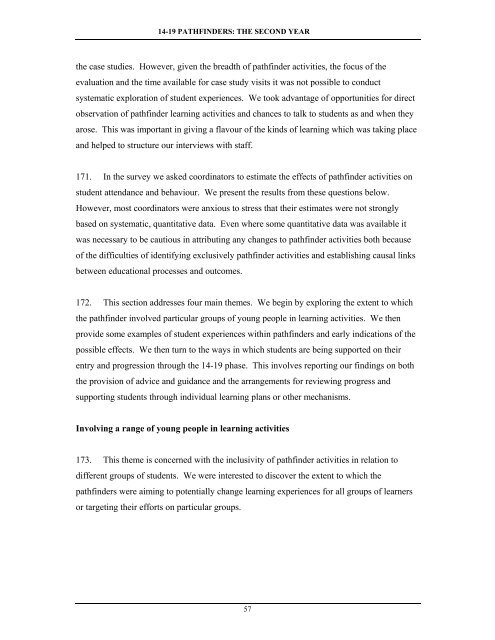Collaborative Approaches to 14-19 Provision - Communities and ...
Collaborative Approaches to 14-19 Provision - Communities and ...
Collaborative Approaches to 14-19 Provision - Communities and ...
- No tags were found...
You also want an ePaper? Increase the reach of your titles
YUMPU automatically turns print PDFs into web optimized ePapers that Google loves.
<strong>14</strong>-<strong>19</strong> PATHFINDERS: THE SECOND YEARthe case studies. However, given the breadth of pathfinder activities, the focus of theevaluation <strong>and</strong> the time available for case study visits it was not possible <strong>to</strong> conductsystematic exploration of student experiences. We <strong>to</strong>ok advantage of opportunities for direc<strong>to</strong>bservation of pathfinder learning activities <strong>and</strong> chances <strong>to</strong> talk <strong>to</strong> students as <strong>and</strong> when theyarose. This was important in giving a flavour of the kinds of learning which was taking place<strong>and</strong> helped <strong>to</strong> structure our interviews with staff.171. In the survey we asked coordina<strong>to</strong>rs <strong>to</strong> estimate the effects of pathfinder activities onstudent attendance <strong>and</strong> behaviour. We present the results from these questions below.However, most coordina<strong>to</strong>rs were anxious <strong>to</strong> stress that their estimates were not stronglybased on systematic, quantitative data. Even where some quantitative data was available itwas necessary <strong>to</strong> be cautious in attributing any changes <strong>to</strong> pathfinder activities both becauseof the difficulties of identifying exclusively pathfinder activities <strong>and</strong> establishing causal linksbetween educational processes <strong>and</strong> outcomes.172. This section addresses four main themes. We begin by exploring the extent <strong>to</strong> whichthe pathfinder involved particular groups of young people in learning activities. We thenprovide some examples of student experiences within pathfinders <strong>and</strong> early indications of thepossible effects. We then turn <strong>to</strong> the ways in which students are being supported on theirentry <strong>and</strong> progression through the <strong>14</strong>-<strong>19</strong> phase. This involves reporting our findings on boththe provision of advice <strong>and</strong> guidance <strong>and</strong> the arrangements for reviewing progress <strong>and</strong>supporting students through individual learning plans or other mechanisms.Involving a range of young people in learning activities173. This theme is concerned with the inclusivity of pathfinder activities in relation <strong>to</strong>different groups of students. We were interested <strong>to</strong> discover the extent <strong>to</strong> which thepathfinders were aiming <strong>to</strong> potentially change learning experiences for all groups of learnersor targeting their efforts on particular groups.57
















